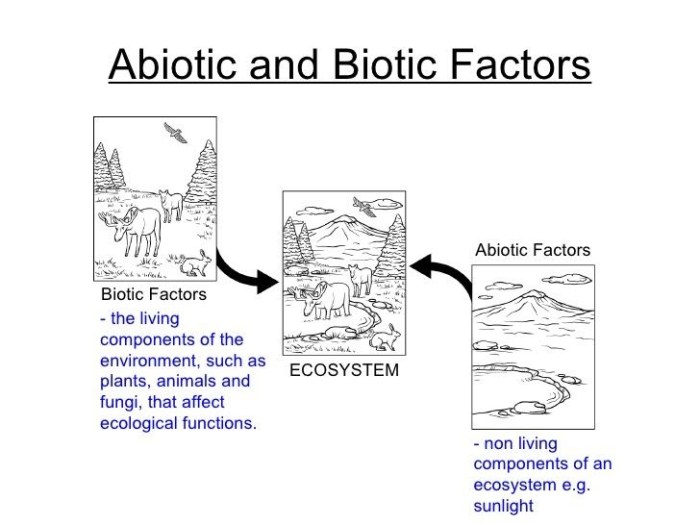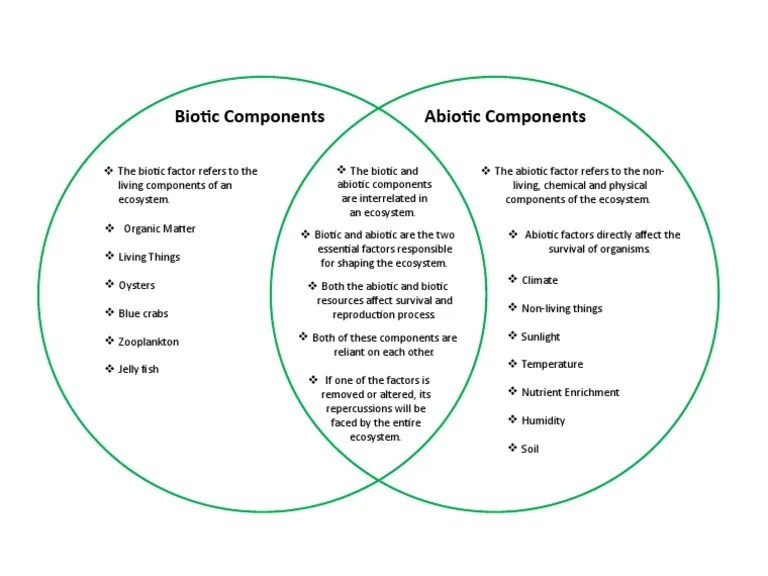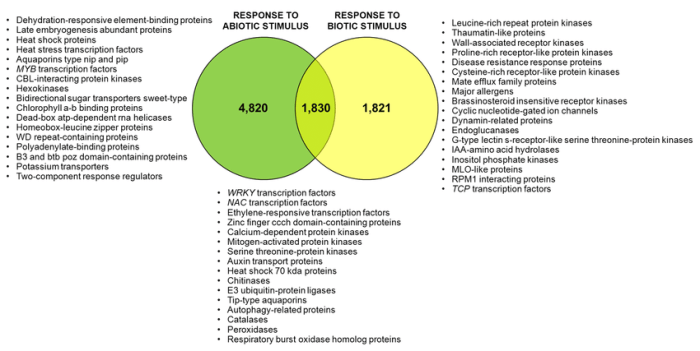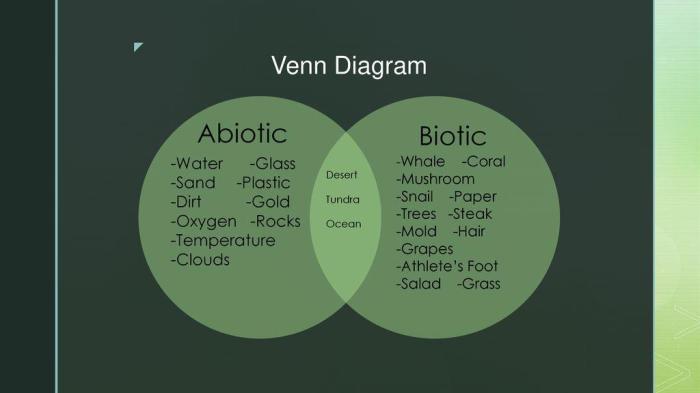Abiotic and biotic venn diagram provides a captivating framework to explore the intricate interplay between living organisms and their surroundings. Join us as we delve into the fascinating world of abiotic and biotic factors, uncovering their significance for ecosystems and the delicate balance of nature.
Abiotic factors, the non-living components of an ecosystem, set the stage for life’s grand performance. From sunlight and temperature to soil composition and water availability, these factors shape the conditions that determine the survival and success of organisms.
Abiotic Factors

In any ecosystem, abiotic factors are non-living chemical and physical components that influence the survival, growth, and distribution of organisms.
Examples of abiotic factors include temperature, water, sunlight, pH, soil type, and atmospheric gases. These factors affect organisms directly or indirectly by influencing their physiological processes, behavior, and habitat availability.
Abiotic and biotic factors form two distinct yet interconnected circles in an ecosystem. While abiotic factors encompass non-living elements like sunlight and temperature, biotic factors include living organisms. Now, consider a bee sting. To alleviate the pain, you might wonder, does chlorine help bee stings ? Returning to our venn diagram, chlorine, as an abiotic factor, can interact with the biotic factor of a bee sting, influencing the outcome.
Understanding these interactions helps us appreciate the intricate balance within ecosystems.
Significance of Abiotic Factors
Abiotic factors play a crucial role in shaping the structure and function of ecosystems. They determine the types of organisms that can thrive in a particular environment and influence their abundance, distribution, and interactions.
For instance, temperature affects the metabolic rates and activity patterns of organisms. Water availability influences plant growth and distribution, while soil type affects nutrient availability and root development.
Biotic Factors

Biotic factors encompass all living organisms within an ecosystem. These organisms interact with each other and their physical environment, influencing the ecosystem’s dynamics and stability. Biotic factors include plants, animals, bacteria, fungi, and other microorganisms.
The significance of biotic factors for living organisms is immense. They provide food, shelter, and protection from predators. Biotic factors also play a crucial role in nutrient cycling, decomposition, and the regulation of atmospheric gases. The presence or absence of specific biotic factors can have a profound impact on the overall health and functioning of an ecosystem.
Producers
- Plants and algae are primary producers, converting sunlight into chemical energy through photosynthesis.
- They form the foundation of food chains and provide sustenance for all other organisms.
Consumers
- Animals, including herbivores, carnivores, and omnivores, are consumers that rely on producers for their nutrition.
- They play a crucial role in energy transfer and nutrient cycling within the ecosystem.
Decomposers
- Bacteria and fungi are decomposers that break down dead organic matter, releasing nutrients back into the soil or water.
- They play a vital role in nutrient recycling and the decomposition of organic waste.
Symbiotic Relationships, Abiotic and biotic venn diagram
- Symbiotic relationships occur when two or more organisms live in close association, benefiting from each other.
- Examples include mutualism, commensalism, and parasitism.
Importance of Biodiversity
The diversity of biotic factors within an ecosystem is crucial for its stability and resilience. Biodiversity ensures that there are multiple species performing similar functions, which provides redundancy and reduces the risk of ecosystem collapse.
Venn Diagram of Abiotic and Biotic Factors: Abiotic And Biotic Venn Diagram

Abiotic and biotic factors interact to create the environment in which organisms live. Abiotic factors are non-living components of the environment, such as sunlight, temperature, water, and soil. Biotic factors are living organisms, such as plants, animals, and microorganisms.
The Venn diagram below shows the relationship between abiotic and biotic factors. The overlapping area of the Venn diagram represents the interactions between abiotic and biotic factors. These interactions are essential for the survival of both abiotic and biotic factors.
Overlapping Area of the Venn Diagram
The overlapping area of the Venn diagram represents the interactions between abiotic and biotic factors. These interactions are essential for the survival of both abiotic and biotic factors. For example, plants need sunlight, water, and soil to grow. Animals need plants and other animals to eat.
Microorganisms help to decompose organic matter, which releases nutrients back into the soil.
Interactions Between Abiotic and Biotic Factors
Abiotic and biotic factors interact in a variety of ways. Some of these interactions are:
- Sunlight:Sunlight is essential for photosynthesis, the process by which plants convert sunlight into energy. Plants use this energy to grow and produce food. Animals rely on plants for food, so sunlight is indirectly essential for animal survival.
- Temperature:Temperature affects the growth and reproduction of both plants and animals. Some organisms are adapted to live in cold climates, while others are adapted to live in warm climates. Temperature can also affect the distribution of organisms. For example, tropical rainforests are found in warm climates, while tundra biomes are found in cold climates.
- Water:Water is essential for all life. Plants and animals need water to survive. Water also helps to regulate temperature and provides a habitat for many organisms.
- Soil:Soil provides nutrients for plants. Plants use these nutrients to grow and produce food. Animals rely on plants for food, so soil is indirectly essential for animal survival.
- Microorganisms:Microorganisms help to decompose organic matter, which releases nutrients back into the soil. These nutrients can then be used by plants to grow. Microorganisms also play a role in the cycling of carbon and nitrogen.
Importance of Abiotic and Biotic Factors for Ecosystems

Ecosystems are complex and dynamic systems that rely on the delicate balance between abiotic (non-living) and biotic (living) factors. These factors interact closely, influencing each other and the overall functioning of the ecosystem.
Interdependence of Abiotic and Biotic Factors
Abiotic and biotic factors are interdependent and rely on each other for survival and sustenance. Abiotic factors, such as sunlight, water, temperature, and soil, provide the essential resources that support the growth and development of biotic factors, including plants, animals, and microorganisms.
Conversely, biotic factors play a crucial role in shaping and modifying abiotic factors. Plants release oxygen into the atmosphere, which is essential for animal respiration. Animals, through their feeding and waste production, contribute to nutrient cycling and soil formation.
Importance of Abiotic Factors for Ecosystems
- Provide Essential Resources:Abiotic factors provide the basic resources necessary for life, such as sunlight, water, and nutrients, which support the growth and development of plants and animals.
- Shape Physical Environment:Abiotic factors determine the physical environment of an ecosystem, including temperature, precipitation, and soil conditions, which influence the distribution and abundance of species.
- Regulate Energy Flow:Abiotic factors, such as sunlight and temperature, regulate the flow of energy through ecosystems, affecting the rates of photosynthesis, respiration, and decomposition.
Importance of Biotic Factors for Ecosystems
- Primary Producers:Plants, as primary producers, convert sunlight into energy through photosynthesis, providing the foundation for food chains and supporting all other organisms.
- Nutrient Cycling:Animals and microorganisms play a vital role in nutrient cycling, breaking down organic matter and releasing nutrients back into the soil and water, making them available for plant growth.
- Habitat Provision:Biotic factors, such as forests and coral reefs, provide shelter, food, and breeding grounds for a diverse array of species, contributing to biodiversity and ecosystem stability.
Case Study: Impact of Climate Change on Abiotic and Biotic Factors

Climate change significantly alters both abiotic and biotic factors in ecosystems, leading to cascading effects. One prominent example is the impact on coral reef ecosystems due to rising sea temperatures.
Changes in Abiotic Factors
- Increased sea temperatures: Rising ocean temperatures due to climate change have a direct impact on coral reefs.
- Ocean acidification: The absorption of carbon dioxide by the ocean leads to increased acidity, affecting the ability of corals to build their calcium carbonate skeletons.
- Sea level rise: Melting glaciers and ice caps contribute to sea level rise, which can submerge coral reefs and alter their light availability.
Changes in Biotic Factors
- Coral bleaching: Elevated sea temperatures cause corals to expel their symbiotic algae, resulting in coral bleaching and reduced growth.
- Loss of biodiversity: Coral reefs support a diverse array of marine life, but climate change-induced stressors can lead to species decline and reduced ecosystem complexity.
- Altered food webs: Changes in coral health and abundance can disrupt food chains and trophic interactions within reef ecosystems.
Consequences for Ecosystems
These changes have severe consequences for coral reef ecosystems:
- Reduced reef productivity: Coral bleaching and loss of biodiversity diminish the ecosystem’s ability to provide food and shelter for marine life.
- Coastal protection: Coral reefs act as natural barriers, protecting coastlines from erosion and storm surges. Their degradation weakens this protection.
- Economic and social impacts: Coral reefs support tourism and fisheries, providing livelihoods for coastal communities. Their decline can have significant socioeconomic consequences.
Essential FAQs
What is an abiotic factor?
An abiotic factor is a non-living component of an ecosystem that influences the survival and distribution of organisms.
What is a biotic factor?
A biotic factor is a living component of an ecosystem that influences the survival and distribution of organisms.
What is the significance of abiotic and biotic factors for ecosystems?
Abiotic and biotic factors interact to create the conditions necessary for life and shape the structure and functioning of ecosystems.